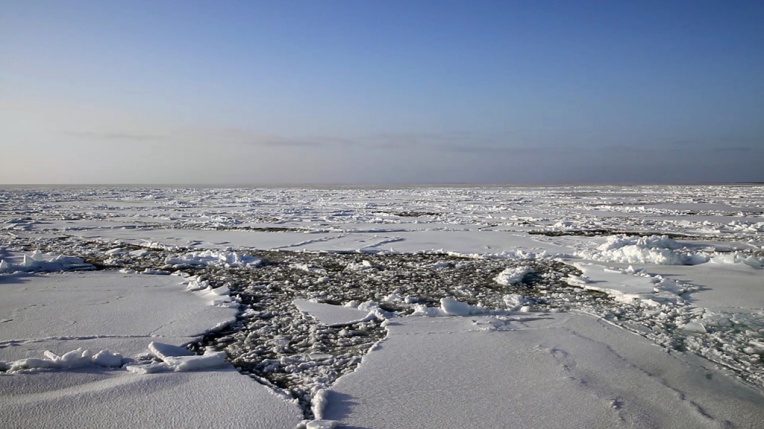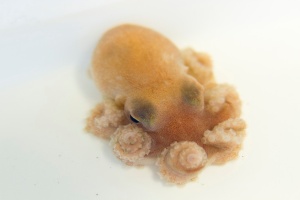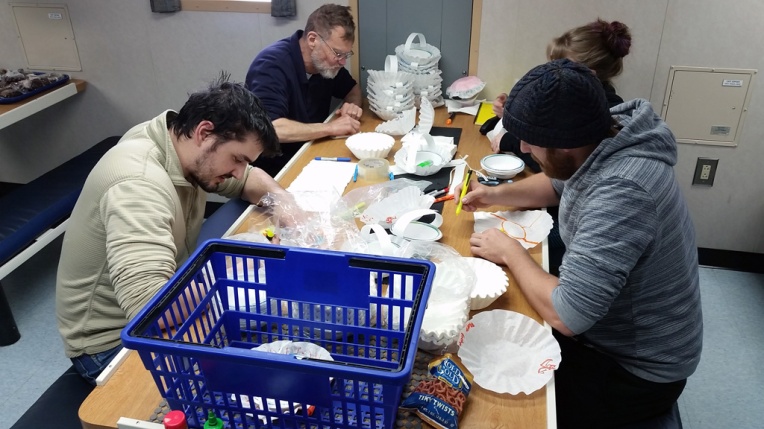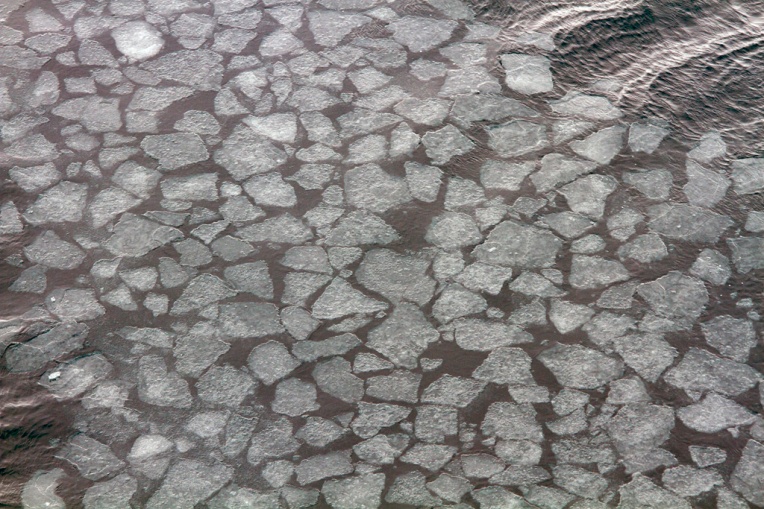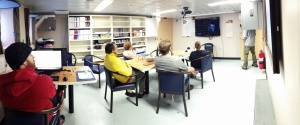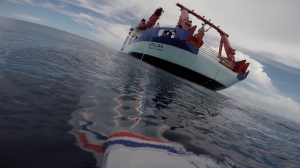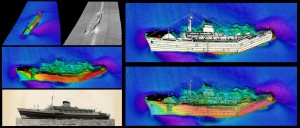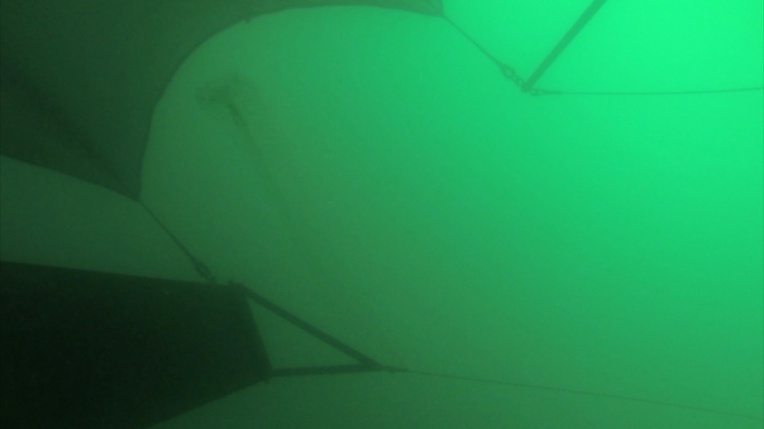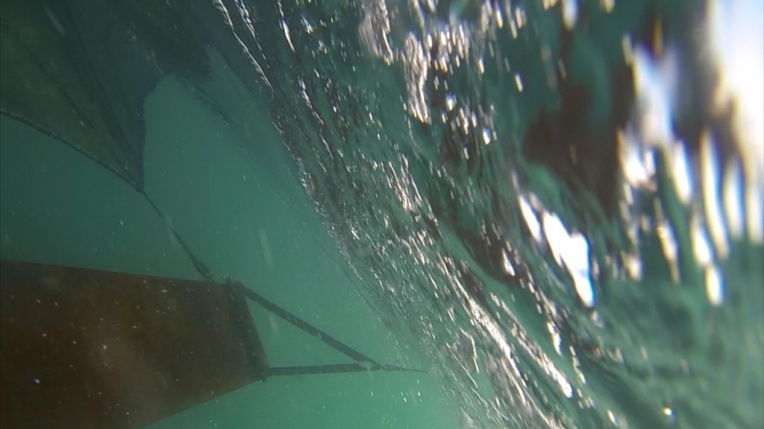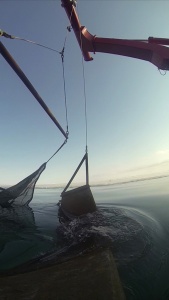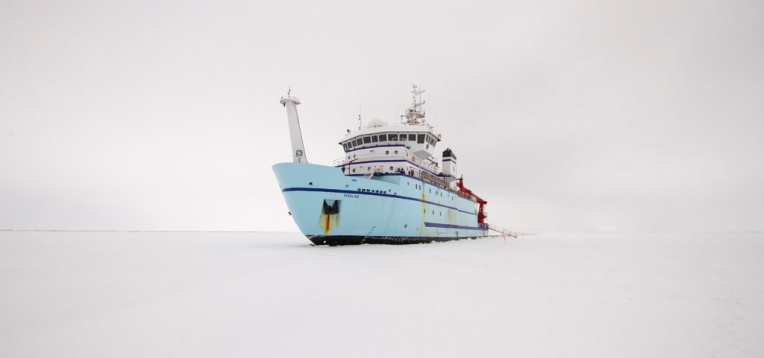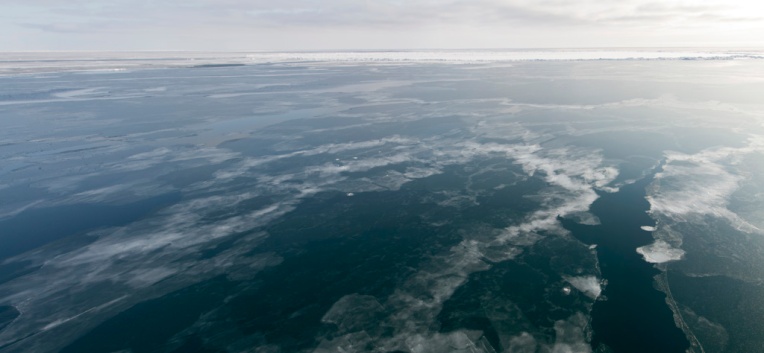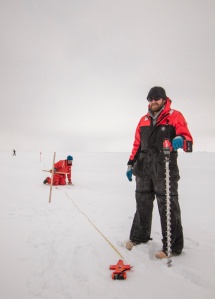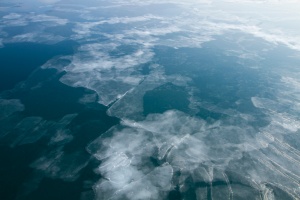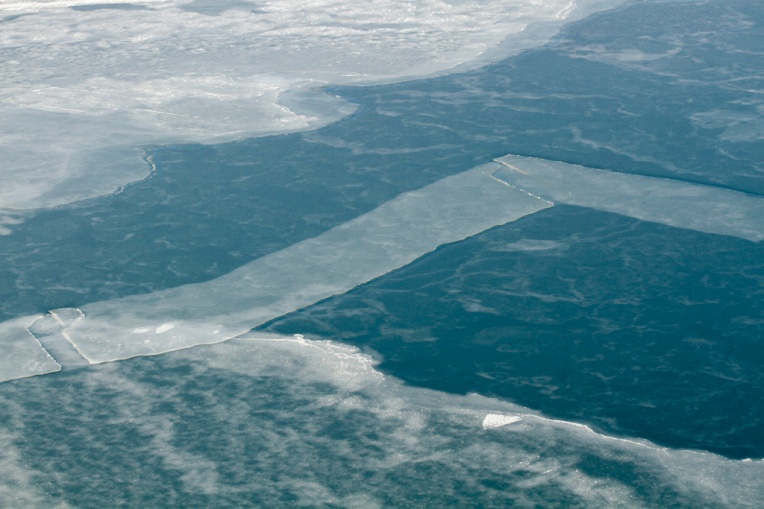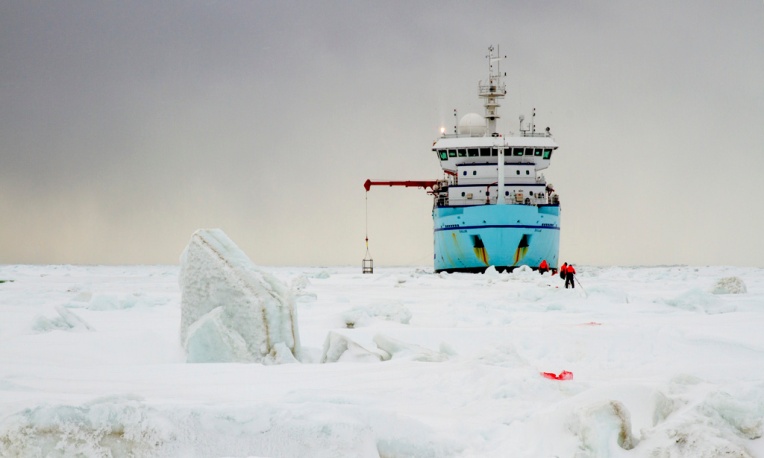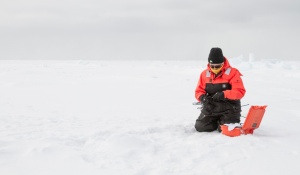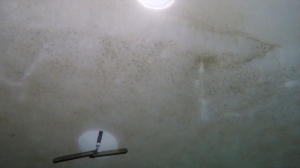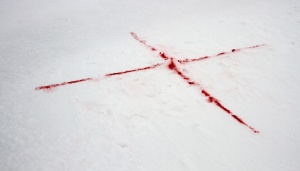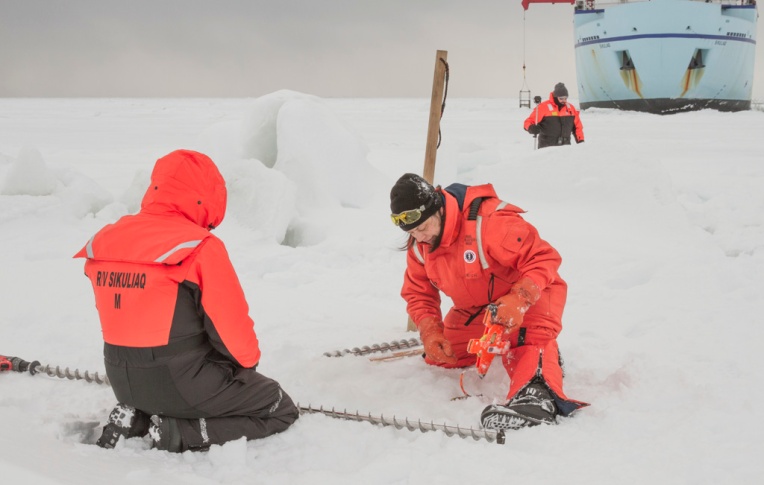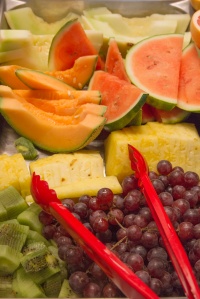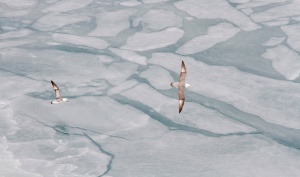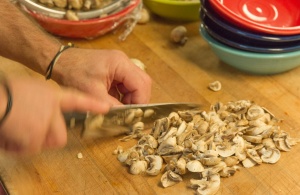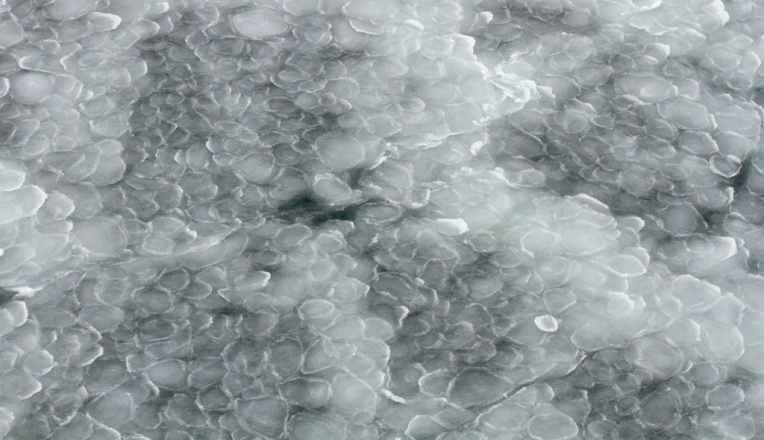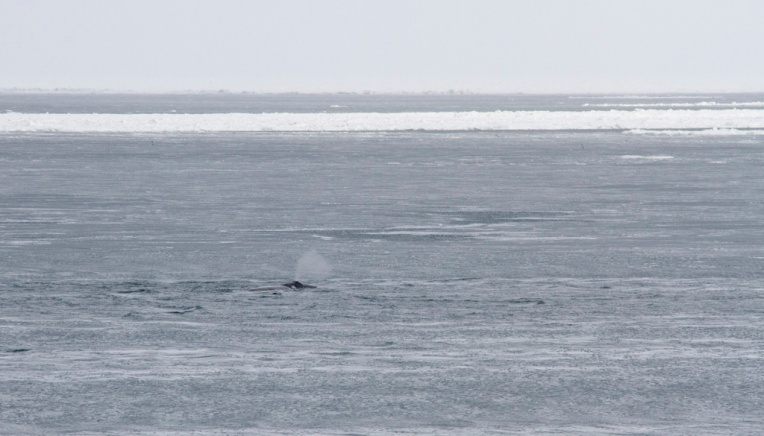Sikuliaq Ice Trials
April 5th, 2015
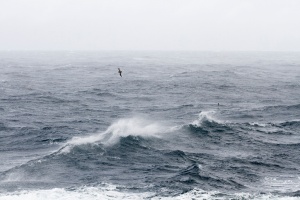
I watch Perry walk down the 01 corridor past the science berthing. He staggers back and forth, trying not to bump into the walls, as if he (and everyone else) has had too much to drink. It’s a dry boat. It’s just the swells, rocking front to back and rolling from side to side. Most times, both at the same time, as if we’re the dregs at the bottom of a glass, being slowly circled about the creases. We get lulled into a routine and then the routine is broken. Amid the predictable rolls there’s a big one thrown in, and this time the whole mattress slides across the pallet. Something you thought has been secure for weeks suddenly isn’t. I point a video camera around the stateroom. The coffee in my mug moves like a sea creature, the life preservers above the closet slide back and forth, the curtains on the bunks drift like it’s finally Spring and the windows are open and the breeze is coming in. The door rattles against its hook and the computer mouse slides clean off the desk. My hat and my raincoat swing back and forth against the wall — and something heavy thumps somewhere on the ship. It might be one of the anchors. It might be something else. The telephone cords swings back and forth and the towels, gravitropic, searches blindly for the center of the earth.
I go outside and take pictures of the swells breaking over the bulwarks of the working deck. I stagger out along the 02 deck, both hands on the handrails, remote camera clipped on to my pants so I can set it up for an hour’s wet shooting while I go back inside. After I collect it later, I don’t have the energy to see what the photos look like. Maybe next week.

The cofferdam is back up in the Baltic room. Of course, it’s snowing again. Upstairs, Matt is chopping vegetables for dinner, his legs spread wide like he’s about to begin a wrestling match. Cubes of the squash he’s cutting are lost to the floor. There’s no helping them. Tony curses from across the galley. There’s no working in this conditions.
We get into another large roll. I look in my coffee cup. The cup’s about three inches in diameter. The coffee just left a tidemark half an inch high on the stainless steel. That’s a slope of 1 in 3 and nothing out of the ordinary on a Monday in the Bering. I rack my brain for the trigonometry. Can’t figure out how to do inverse tangents on my phone but I know how to try a bunch of numbers (like passwords) and with a little brute force … an 18 (ish) degree roll that time. Ah, the daily applications of math while being tossed about at sea. See kids, math is useful. Math quantifies what your gut already knows.
Matt talks about not changing the galley’s big mixer once he ship goes into the yard. He refers to it as Frank, for obvious reasons I guess, if you know your industrial mixers. Turns out Frank took a tumble on a now infamous roll the ship made when it crossed the Pacific from Guam to Ketchikan. “That thing’s heavy,” says Elliot. “You have to tie it down.”
Oh, it was tied down. The thing ripped itself loose. Now, despite its dents, Frank’s one of the family. Frank has seen things.
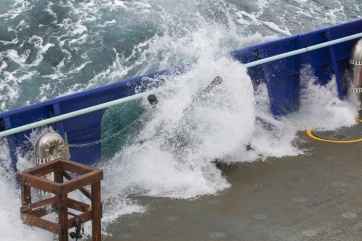
…
Just spent the last 5 minutes recording the sound of strange, high-pitched song that seemed to be coming out of the wall and desk in my stateroom. It plays in time with the rock and roll. I hope I can hear it later in the headphones amid the rustle of the coats and the creaking of the bunks and the rattle of a jellybean lost in the desk drawer. I’ve eaten the rest but this one eludes me. Scratch and thump, the mouse takes another flying leap across the room. Perry comes in to get his camera. I ask him if he can hear the song. He can. He can. So there. I’m not imagining everything.
…
Sounds like someone is loading a dishwasher in the gallery but really there’s no one there. There are not enough dishtowels to stuff between the stack of plates to keep them rattling. The springs yawn, tired as everyone else. The chairs in the lounge are sliding back and forth, restrained only by being bungeed to the floor, the table, and each other. The corridors and the public spaces are vacant. If someone’s out of his or her bunk, it is to use the head or grab crackers from the mess or to stand watch. The only sensible thing to do is to try and sleep through it. I’ll be glad once night arrives and it no longer makes much sense to take pictures.
…
Standing on the bridge is an amusement ride and a circus. The Bridge wings are the highest, outermost part of the ship’s interior and there you get the strongest rush, the biggest arc through space. Once you know which way is ground, it’s gone and you have to find it again. The Mate on duty does magic, standing at impossible angles to the floor. The ship rears up and plunges head first into a hole in the ocean. Spray explodes around the bow and the science mast and reaches (I think) as high as the Bridge. It really matters which way was up at the time. These icebreaker hulls roll in open water like bath toys. Going back down the stairs you are in one moment weightless and floating, and in the next putting on fifty pounds.

I photograph and film more white caps and storm cells moving across the water. Waves try and sweep the deck and we tack our way slowly south. Perry and I have left our stateroom door open again to prevent problems with the lock. When I get back I’m told my chair tried to make an escape into the corridor. As I sit here typing, Perry’s toothpaste makes a run for it across ten feet of carpet. I wait for us to roll the other way and the tube comes flying back to me where I can pick it up without leaving my chair.
…
April 7th
About 36 hours later we steam into safe harbor. No one has slept well if at all. We’ve arrived a day before we can tie up, so we park the ship in a cove below the mountains of Unalaska. We’ve got a lot of cleaning and packing to do — and then sleep. Lots of sleep. And showers!
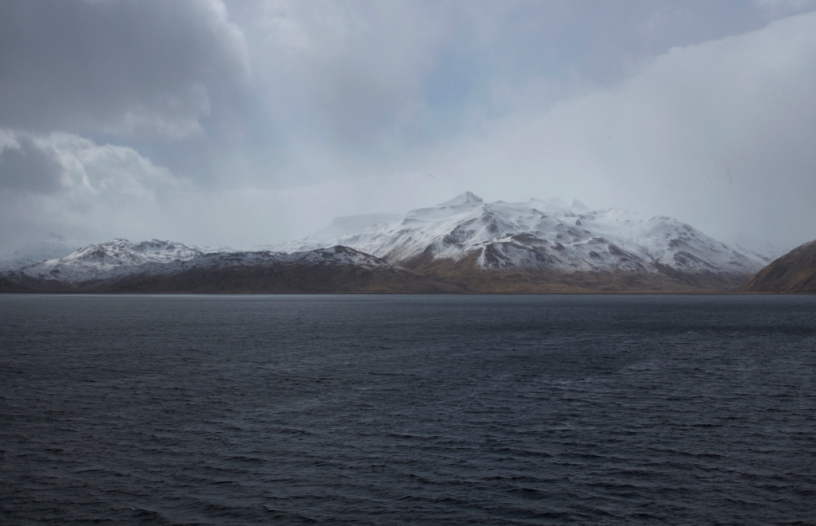
…
Tomorrow we’ll dock and stretch our legs, having pretty much all the gear already sealed and labeled for shipping, and our carried bags mostly packed for when the fun of catching flights begins on Thursday. The trip’s not over, but it’s a good a stopping point as any. The journey never ends.
April 8th
We’re tied up to the slip. Everyone is smiles. The rental trucks are in the parking lot and Brandon has his boots and backpack on for a hike somewhere, anywhere. The mountains are gorgeous and the snow line has come down since we left three weeks ago. You would think it was fall already.
Come the weekend the ship will leave port and head back to Seward. And from there, the adventures will continue. Thanks for the ride Sikuliaq. I am now going to take a walk on dry land (wet, actually, because this is the Aleutians) and try not to fall over my own feet. Cheers.
— Roger Topp (UAMN Head of Exhibits, Design, and Digital Media Production)

